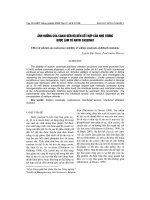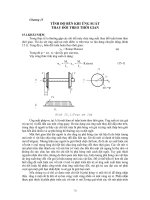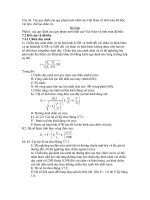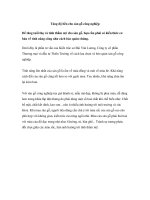đo độ bền bọt
Bạn đang xem bản rút gọn của tài liệu. Xem và tải ngay bản đầy đủ của tài liệu tại đây (132.63 KB, 4 trang )
ĐO ĐỘ BỀ BỌT
1. Ly đo độ bền bọt:
- Đường kính 60mm, chiều cao 120mm.
- Được rửa sạch, sấy khơ, được được để bám vết xà phòng trên ly.
- Dùng bút lơng khơng xóa được vạch bê ngồi thành ly 2 vạch như sau:
+ Vạch số 2 cách mép thành ly 1 cm.
+ Vạch số 3 cách vạch số 2: 3cm
- Ngồi ra cịn dùng thêm đồng hồ bấm giây.
2. Đo độ bề bọt:
a. Khi có dụng cụ lấy mẫu:
- Áp lực khí để ép bia trong chai/lon qua vịi là 2,5 bar.
- Nhiệt độ bia trong khi đo 20oC (càng chính xác càng tốt).
- Lần đầu tiên, lấy bọt vào ly thường đến khi thấy bọt mịn, đều.
- Sau đó, mới lấy bọt vào ly để đo thời gian.
- Quan sát khi phần bọt ở trung tâm ly vượt qua vạch số 2
thì bắt đầu bấm giây.
- Khi phần bọt ở trung tâm ly vượt qua vạch số 3 thì bấm
dừng đếm giây.
- Thời gian đo được chính là độ bề bọt.
Lưu ý: Trong quá trình đo nên đặt ly trong tủ ổn định nhiệt ở 20oC
hoặc ngâm trong chậu nước để giữa ở 20oC.
b. Khi khơng có dụng cụ lấy mẫu:
- Nhiệt độ bia trong khi rót: 20oC
- Rót mạnh bia vào ly (bọt càng mịn, càng đều càng tốt).
- Sau đó bắt đầu tính giờ như trên.
3. Dụng cụ lấy mẫu:
- ISD inpack 2000 nên chọn loại có van 3 ngã để kết hợp
đo oxy trong bào bì sau này.
Checklist Foam Management
Parameter
Standard
Priority
2)
Remark
(including weak wort collection):
Reuse of weak wort
Wort boiling
Δ T during heating-up:
allowed
*
Trend: no reuse more foam.
< 8°C
*
Hop dosing moment:
> 90 °C
*
Boiling time (as from kettle full)
> 75 minutes
a. Internal boilers: 5 – 6 %/hr
b. External boilers: 4 – 5 %/hr
c. Dynamic boilers: 3 – 4 %/hr
**
Trend: higher Δ T less foam.
Target: 90 °C (to avoid foam formation in
kettle).
Trend: longer boiling less foam.
**
Trend: More intense less foam.
< 104°C
**
Trend: higher temperature less foam.
minimal
*
Any foam produced is foam lost.
Evaporation rate per hour
(boiling intensity)
Wort temperature in the heater
during boiling:
Foaming during boil
Wort Treatment
Maximum trub/sludge content
pitching wort:
Yeast Management
General remark:
Yeast dosage (g at 100%/hl)
*Corrected for dead cells
Dead cells %
Yeast Generation (#)
Fermentation &
Lagering
< 0.15 gr/l
Appy “Good Yeast
Management” principles.
min. 150 g/hl
max. 250 g/hl
< 5%
≤4
**
****
*
***
**
Fermentation speed
1.6 ± 0.2% w/w/24 hrs
*
Anti-foams
To be prevented
*
Foam formation during filling of
fermenter and lagertank:
Minimal
*
Overfoaming of fermenters:
To be avoided.
*
Haze increase young beer due
to autolysis of yeast.
< 0.4 EBC turbidity increase
(wort to young beer at 15 °P
of filtered samples)
Yeast temperature in cone of
fermenter and lagertank.
2 °C above fermentation temp.
pH increase during cold storage ≤ 0.1
- after yeast harvest
- After deepcooling.
Purge during cold storage
- During lagering: 1x per week.
- Just before filtration.
Number of yeast cells at the end < 5 million cells/ml
of cold storage:
***
**
***
**
**
Trend: higher trub content less foam.
Trend: poor yeast management less
foam.
Trend: too high or too low dosage less
foam
Trend: high % dead cells less foam.
Trend: higher generation less foam.
Trend: too high or too low fermentation
speed less foam.
Trend: too high dose less
foam.
Any foam produced is foam
lost.
Any foam lost is a lower foam
stability.
Trend: Higher haze less
foam.
Trend: High temperature
more yeast autolysis less
foam. Appy cone cooling.
Trend: pH increase less
foam.
Trend: less purging more
yeast autolysis less foam.
Aim: < 0.5 million cells/ml.
More yeast in suspension
Parameter
Standard
Priority
2)
Remark
higher risk yeast autolyses
less foam.
Cold storage temperature
(measured just above cone of
vertical FST).
-1 till +0 °C
Process Time:
Rest beer from surplus yeast
Rest beer recuperated from
surplus yeast:
Storage time surplus yeast:
Storage temperature of surplus
yeast:
% Dead cells of surplus yeast:
Heat treatment of restbeer with
> 1.000.000 yeast cells/ml or
> 3 EBC:
pH of unpasteurised restbeer
recuperated from surplus yeast:
Rest beer storage time:
Rest beer storage temperature:
Kieselguhr consumption:
PVPP dosage
PVPP regeneration:
Silica dosage:
Tannic acid:
Foam formation during filling of
bright beer tanks:
Washing of BBT’s with CO2:
Pasteurisation
*
Trend: higher temperature
less foam
- Min. 28 days at max.15% w/w
- Max. 56 days.
**
Aim: 28 days.
Longer process time higher
risk yeast autolyses less
foam.
To be prevented.
**
Trend: too high dose less foam
- preferably within 24 hours.
- maximum 48 hours.
**
< 2 ºC
***
< 5%
**
Not allowed.
*
Trend: usage of heat treated restbeer
with high turbidity less foam.
pm
**
< 3 days
< 3 ºC
**
**
< 200 gr/hl
*
Trend: too high dose adsorption of
foam positive components less foam
*
Trend: too high dose less foam
Sufficient to achieve a Total
Polyphenol reduction:
- minimal 25%
- maximum 60%
- Use foodgrade caustic
- Use foodgrade acid
Correct dose
2 to 10 g/hl
minimal
To be avoided
*
*
**
*
**
15 ± 5 PU
*
- Use food-grade lubricants.
- Avoid excessive lubrication.
- Inspect seamer every 8 hrs.
- Clean seamer every 8 hrs.
*
Can Filling
Lubrication of seamer heads:
Trend: Long storage yeast autolysis
less foam.
Trend: High temperature yeast
autolysis less foam.
Trend: high % dead cells less foam.
(Aim: same as beer ?)
To avoid contamination of PVPP with
foam negative components.
Trend: too high dose less foam
Aim: avoid the use of Tannic acid.
Any foam produced is foam lost.
Any foam produced is foam lost.
Pasteurisation inactivates proteolytic
enzymes.









